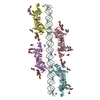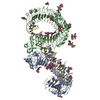[English] 日本語
 Yorodumi
Yorodumi- EMDB-32599: Cryo-EM structure of tetrameric TLR3 in complex with dsRNA (90 bp) -
+ Open data
Open data
- Basic information
Basic information
| Entry |  | ||||||||||||
|---|---|---|---|---|---|---|---|---|---|---|---|---|---|
| Title | Cryo-EM structure of tetrameric TLR3 in complex with dsRNA (90 bp) | ||||||||||||
 Map data Map data | |||||||||||||
 Sample Sample |
| ||||||||||||
 Keywords Keywords |  innate immunity / innate immunity /  IMMUNE SYSTEM / IMMUNE SYSTEM /  IMMUNE SYSTEM-RNA complex IMMUNE SYSTEM-RNA complex | ||||||||||||
| Function / homology |  Function and homology information Function and homology informationtype III interferon production / positive regulation of type III interferon production / response to dsRNA / regulation of dendritic cell cytokine production / inflammatory response to wounding / toll-like receptor 3 signaling pathway / necroptotic signaling pathway / positive regulation of cytokine production involved in inflammatory response / positive regulation of macrophage cytokine production /  pattern recognition receptor activity ...type III interferon production / positive regulation of type III interferon production / response to dsRNA / regulation of dendritic cell cytokine production / inflammatory response to wounding / toll-like receptor 3 signaling pathway / necroptotic signaling pathway / positive regulation of cytokine production involved in inflammatory response / positive regulation of macrophage cytokine production / pattern recognition receptor activity ...type III interferon production / positive regulation of type III interferon production / response to dsRNA / regulation of dendritic cell cytokine production / inflammatory response to wounding / toll-like receptor 3 signaling pathway / necroptotic signaling pathway / positive regulation of cytokine production involved in inflammatory response / positive regulation of macrophage cytokine production /  pattern recognition receptor activity / pattern recognition receptor activity /  toll-like receptor signaling pathway / response to exogenous dsRNA / cellular response to exogenous dsRNA / positive regulation of interferon-alpha production / positive regulation of type I interferon production / cellular response to interferon-beta / positive regulation of chemokine production / extrinsic apoptotic signaling pathway / JNK cascade / positive regulation of interleukin-12 production / positive regulation of interferon-beta production / positive regulation of interleukin-8 production / microglial cell activation / positive regulation of JNK cascade / response to virus / defense response / cellular response to virus / cellular response to type II interferon / positive regulation of interleukin-6 production / positive regulation of non-canonical NF-kappaB signal transduction / cellular response to mechanical stimulus / male gonad development / positive regulation of angiogenesis / toll-like receptor signaling pathway / response to exogenous dsRNA / cellular response to exogenous dsRNA / positive regulation of interferon-alpha production / positive regulation of type I interferon production / cellular response to interferon-beta / positive regulation of chemokine production / extrinsic apoptotic signaling pathway / JNK cascade / positive regulation of interleukin-12 production / positive regulation of interferon-beta production / positive regulation of interleukin-8 production / microglial cell activation / positive regulation of JNK cascade / response to virus / defense response / cellular response to virus / cellular response to type II interferon / positive regulation of interleukin-6 production / positive regulation of non-canonical NF-kappaB signal transduction / cellular response to mechanical stimulus / male gonad development / positive regulation of angiogenesis /  MAPK cascade / transmembrane signaling receptor activity / positive regulation of type II interferon production / cellular response to xenobiotic stimulus / MAPK cascade / transmembrane signaling receptor activity / positive regulation of type II interferon production / cellular response to xenobiotic stimulus /  double-stranded RNA binding / positive regulation of tumor necrosis factor production / double-stranded RNA binding / positive regulation of tumor necrosis factor production /  signaling receptor activity / defense response to virus / positive regulation of canonical NF-kappaB signal transduction / signaling receptor activity / defense response to virus / positive regulation of canonical NF-kappaB signal transduction /  early endosome / endosome membrane / early endosome / endosome membrane /  inflammatory response / positive regulation of apoptotic process / inflammatory response / positive regulation of apoptotic process /  innate immune response / endoplasmic reticulum membrane / positive regulation of gene expression / innate immune response / endoplasmic reticulum membrane / positive regulation of gene expression /  cell surface / positive regulation of transcription by RNA polymerase II / identical protein binding / cell surface / positive regulation of transcription by RNA polymerase II / identical protein binding /  plasma membrane / plasma membrane /  cytoplasm cytoplasmSimilarity search - Function | ||||||||||||
| Biological species |   Mus musculus (house mouse) / synthetic construct (others) Mus musculus (house mouse) / synthetic construct (others) | ||||||||||||
| Method |  single particle reconstruction / single particle reconstruction /  cryo EM / Resolution: 3.2 Å cryo EM / Resolution: 3.2 Å | ||||||||||||
 Authors Authors | Sakaniwa K / Ohto U | ||||||||||||
| Funding support |  Japan, 3 items Japan, 3 items
| ||||||||||||
 Citation Citation |  Journal: Nat Commun / Year: 2023 Journal: Nat Commun / Year: 2023Title: TLR3 forms a laterally aligned multimeric complex along double-stranded RNA for efficient signal transduction. Authors: Kentaro Sakaniwa / Akiko Fujimura / Takuma Shibata / Hideki Shigematsu / Toru Ekimoto / Masaki Yamamoto / Mitsunori Ikeguchi / Kensuke Miyake / Umeharu Ohto / Toshiyuki Shimizu /  Abstract: Toll-like receptor 3 (TLR3) is a member of the TLR family, which plays an important role in the innate immune system and is responsible for recognizing viral double-stranded RNA (dsRNA). Previous ...Toll-like receptor 3 (TLR3) is a member of the TLR family, which plays an important role in the innate immune system and is responsible for recognizing viral double-stranded RNA (dsRNA). Previous biochemical and structural studies have revealed that a minimum length of approximately 40-50 base pairs of dsRNA is necessary for TLR3 binding and dimerization. However, efficient TLR3 activation requires longer dsRNA and the molecular mechanism underlying its dsRNA length-dependent activation remains unknown. Here, we report cryo-electron microscopy analyses of TLR3 complexed with longer dsRNA. TLR3 dimers laterally form a higher multimeric complex along dsRNA, providing the basis for cooperative binding and efficient signal transduction. | ||||||||||||
| History |
|
- Structure visualization
Structure visualization
| Supplemental images |
|---|
- Downloads & links
Downloads & links
-EMDB archive
| Map data |  emd_32599.map.gz emd_32599.map.gz | 41.5 MB |  EMDB map data format EMDB map data format | |
|---|---|---|---|---|
| Header (meta data) |  emd-32599-v30.xml emd-32599-v30.xml emd-32599.xml emd-32599.xml | 12.5 KB 12.5 KB | Display Display |  EMDB header EMDB header |
| Images |  emd_32599.png emd_32599.png | 61.5 KB | ||
| Archive directory |  http://ftp.pdbj.org/pub/emdb/structures/EMD-32599 http://ftp.pdbj.org/pub/emdb/structures/EMD-32599 ftp://ftp.pdbj.org/pub/emdb/structures/EMD-32599 ftp://ftp.pdbj.org/pub/emdb/structures/EMD-32599 | HTTPS FTP |
-Related structure data
| Related structure data |  7wm4MC M: atomic model generated by this map C: citing same article ( |
|---|---|
| Similar structure data | Similarity search - Function & homology  F&H Search F&H Search |
- Links
Links
| EMDB pages |  EMDB (EBI/PDBe) / EMDB (EBI/PDBe) /  EMDataResource EMDataResource |
|---|---|
| Related items in Molecule of the Month |
- Map
Map
| File |  Download / File: emd_32599.map.gz / Format: CCP4 / Size: 83.7 MB / Type: IMAGE STORED AS FLOATING POINT NUMBER (4 BYTES) Download / File: emd_32599.map.gz / Format: CCP4 / Size: 83.7 MB / Type: IMAGE STORED AS FLOATING POINT NUMBER (4 BYTES) | ||||||||||||||||||||
|---|---|---|---|---|---|---|---|---|---|---|---|---|---|---|---|---|---|---|---|---|---|
| Voxel size | X=Y=Z: 1.128 Å | ||||||||||||||||||||
| Density |
| ||||||||||||||||||||
| Symmetry | Space group: 1 | ||||||||||||||||||||
| Details | EMDB XML:
|
-Supplemental data
- Sample components
Sample components
-Entire : Tetrameric TLR3 in complex with dsRNA (90 bp)
| Entire | Name: Tetrameric TLR3 in complex with dsRNA (90 bp) |
|---|---|
| Components |
|
-Supramolecule #1: Tetrameric TLR3 in complex with dsRNA (90 bp)
| Supramolecule | Name: Tetrameric TLR3 in complex with dsRNA (90 bp) / type: complex / ID: 1 / Parent: 0 / Macromolecule list: #1-#3 |
|---|---|
| Source (natural) | Organism:   Mus musculus (house mouse) Mus musculus (house mouse) |
-Macromolecule #1: Toll-like receptor 3
| Macromolecule | Name: Toll-like receptor 3 / type: protein_or_peptide / ID: 1 / Number of copies: 4 / Enantiomer: LEVO |
|---|---|
| Source (natural) | Organism:   Mus musculus (house mouse) Mus musculus (house mouse) |
| Molecular weight | Theoretical: 77.365852 KDa |
| Recombinant expression | Organism:   Homo sapiens (human) Homo sapiens (human) |
| Sequence | String: TNQCTVRYNV ADCSHLKLTH IPDDLPSNIT VLNLTHNQLR RLPPTNFTRY SQLAILDAGF NSISKLEPEL CQILPLLKVL NLQHNELSQ ISDQTFVFCT NLTELDLMSN SIHKIKSNPF KNQKNLIKLD LSHNGLSSTK LGTGVQLENL QELLLAKNKI L ALRSEELE ...String: TNQCTVRYNV ADCSHLKLTH IPDDLPSNIT VLNLTHNQLR RLPPTNFTRY SQLAILDAGF NSISKLEPEL CQILPLLKVL NLQHNELSQ ISDQTFVFCT NLTELDLMSN SIHKIKSNPF KNQKNLIKLD LSHNGLSSTK LGTGVQLENL QELLLAKNKI L ALRSEELE FLGNSSLRKL DLSSNPLKEF SPGCFQTIGK LFALLLNNAQ LNPHLTEKLC WELSNTSIQN LSLANNQLLA TS ESTFSGL KWTNLTQLDL SYNNLHDVGN GSFSYLPSLR YLSLEYNNIQ RLSPRSFYGL SNLRYLSLKR AFTKQSVSLA SHP NIDDFS FQWLKYLEYL NMDDNNIPST KSNTFTGLVS LKYLSLSKTF TSLQTLTNET FVSLAHSPLL TLNLTKNHIS KIAN GTFSW LGQLRILDLG LNEIEQKLSG QEWRGLRNIF EIYLSYNKYL QLSTSSFALV PSLQRLMLRR VALKNVDISP SPFRP LRNL TILDLSNNNI ANINEDLLEG LENLEILDFQ HNNLARLWKR ANPGGPVNFL KGLSHLHILN LESNGLDEIP VGVFKN LFE LKSINLGLNN LNKLEPFIFD DQTSLRSLNL QKNLITSVEK DVFGPPFQNL NSLDMRFNPF DCTCESISWF VNWINQT HT NISELSTHYL CNTPHHYYGF PLKLFDTSSC KDSAPFEL UniProtKB:  Toll-like receptor 3 Toll-like receptor 3 |
-Macromolecule #2: RNA (81-MER)
| Macromolecule | Name: RNA (81-MER) / type: rna / ID: 2 / Number of copies: 1 |
|---|---|
| Source (natural) | Organism: synthetic construct (others) |
| Molecular weight | Theoretical: 25.699127 KDa |
| Sequence | String: AAAAAAAAAA AAAAAAAAAA AAAAAAAAAA AAAAAAAAAA AUUUUUUUUU UUUUUUUUUU UUUUUUUUUU UUUUUUUUUU U |
-Macromolecule #3: RNA (81-MER)
| Macromolecule | Name: RNA (81-MER) / type: rna / ID: 3 / Number of copies: 1 |
|---|---|
| Source (natural) | Organism: synthetic construct (others) |
| Molecular weight | Theoretical: 25.676088 KDa |
| Sequence | String: AAAAAAAAAA AAAAAAAAAA AAAAAAAAAA AAAAAAAAAA UUUUUUUUUU UUUUUUUUUU UUUUUUUUUU UUUUUUUUUU U |
-Macromolecule #6: 2-acetamido-2-deoxy-beta-D-glucopyranose
| Macromolecule | Name: 2-acetamido-2-deoxy-beta-D-glucopyranose / type: ligand / ID: 6 / Number of copies: 12 / Formula: NAG |
|---|---|
| Molecular weight | Theoretical: 221.208 Da |
| Chemical component information |  ChemComp-NAG: |
-Experimental details
-Structure determination
| Method |  cryo EM cryo EM |
|---|---|
 Processing Processing |  single particle reconstruction single particle reconstruction |
| Aggregation state | particle |
- Sample preparation
Sample preparation
| Concentration | 0.2 mg/mL |
|---|---|
| Buffer | pH: 5.3 / Details: 25 mM MES-NaOH pH 5.3, 0.3 M NaCl |
| Sugar embedding | Material: ice |
| Vitrification | Cryogen name: ETHANE / Instrument: FEI VITROBOT MARK IV |
- Electron microscopy
Electron microscopy
| Microscope | JEOL CRYO ARM 300 |
|---|---|
| Electron beam | Acceleration voltage: 300 kV / Electron source:  FIELD EMISSION GUN FIELD EMISSION GUN |
| Electron optics | Illumination mode: FLOOD BEAM / Imaging mode: BRIGHT FIELD Bright-field microscopy / Nominal defocus max: 2.4 µm / Nominal defocus min: 1.4000000000000001 µm Bright-field microscopy / Nominal defocus max: 2.4 µm / Nominal defocus min: 1.4000000000000001 µm |
| Image recording | Film or detector model: GATAN K3 (6k x 4k) / Average electron dose: 50.0 e/Å2 |
- Image processing
Image processing
| Startup model | Type of model: PDB ENTRY PDB model - PDB ID: |
|---|---|
| Initial angle assignment | Type: MAXIMUM LIKELIHOOD |
| Final angle assignment | Type: MAXIMUM LIKELIHOOD |
| Final reconstruction | Resolution.type: BY AUTHOR / Resolution: 3.2 Å / Resolution method: FSC 0.143 CUT-OFF / Number images used: 274002 |
 Movie
Movie Controller
Controller









